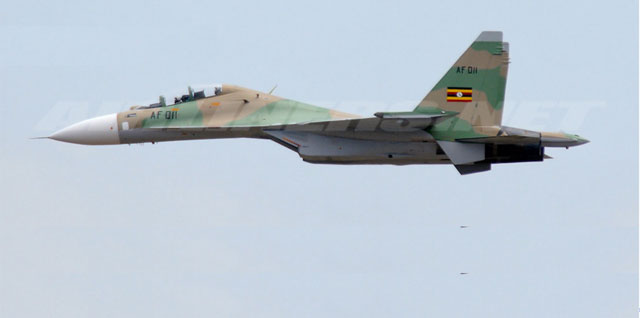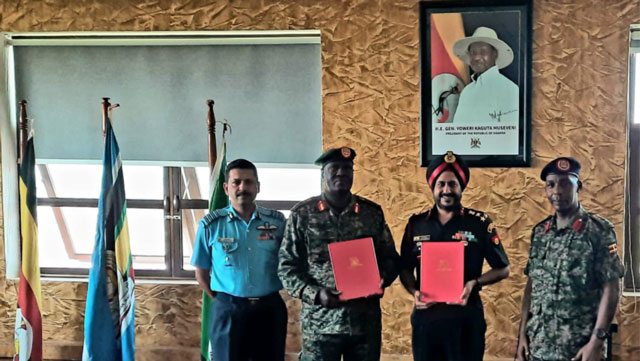
The Asian nation’s move is seen as pushing Russia’s influence in Africa
Kampala, Uganda | IAN KATUSIIME | Uganda has signed a Memorandum of Understanding with India for the maintenance and technical support of the Sukhoi SU-MK30 fighter jets Uganda purchased from Russia more than a decade ago.
The maintenance will be done by Indian state-owned aerospace and defence company, Hindustan Aeronautics Limited (HAL). The Indian company has a manufacturing license from Russia to build the fighter aircraft.
The MoU was signed on March 4 at the Indian High Commission in Kampala. Lt. Gen. Charles Lutaaya, Commander of Air Force in the Uganda Peoples Defence Forces (UPDF), signed on behalf of Uganda.
The Indian High Commission on its Twitter account said the deal was the first major defence agreement with Uganda following Prime Minister Narendra Modi’s unveiling of ’10 Principles of India-Africa Engagement’ in the Ugandan Parliament on July 25, 2018.
Financial details of the deal remain a secret but the arrangement is raising debate among military analysts about the future of Uganda’s super jets.
Lt. Col. Ronald Kakurungu, the spokesperson of the UPDF told The Independent that Uganda used the SU-MK30 jets when it bombed camps of the Allied Democratic Forces (ADF) in November 2021 at the start of the hunt for ADF militants in DR Congo in Operation Shujaa.
Kakurungu, however, declined to comment on where else Uganda has used the jets in Uganda’s vast military footprint in the Great Lakes region. Uganda is known for its penchant for Russian weapons.
Between 2011 and 2012, Uganda acquired six SU-30MK fighter jets from Russia at a price of $635m according to Stockholm International Peace Research Institute (SIPRI), an institute dedicated to research into conflict, armaments, arms control and disarmament.

aircraft (PHOTO/INDIAN HIGH COMMISSION)
Other weapons Uganda has purchased from Russia include T-90 tanks, Kornet anti-tank missiles, anti-ship missiles, Infantry Fighting Vehicles (IFVs), and other components of the SU-30 combat aircraft. SIPRI data show that Uganda took delivery of 1,000 Kornet anti-tank missiles between 2012 and 2013.
However the Russian Sukhoi Su-30MK fighter jets are arguably Uganda’s most prized military asset. The country however has not routinely used the Sukhoi jets in its military adventures in the region where its operations have at once stretched from DR Congo to Central African Republic and Somalia in a period spanning ten years.
The African Union Mission in Somalia (AMISOM) is Uganda’s most engaging military enterprise currently in its fifteenth year of operation. Although it is essentially a peacekeeping mission, Ugandan troops have many times engaged in offensive warfare to deal with the deadly Al Shabaab terrorists in retaliatory attacks in fierce battles in Mogadishu, Somalia’s capital, and other parts in the Horn of Africa country.
But Sukhoi jets are not even used in AMISOM operations, Kakurungu and another military source familiar with AMISOM operations told The Independent.
Russia weapons in Africa
Beyond Uganda, Russian remains the biggest supplier of weapons in Africa. The latest report by SIPRI reveals that Russia was the largest supplier of weapons for African countries for the period ranging from 2017-2021.
Russia’s weapons sales to Africa accounted for 44% of imports of major arms to the continent followed by the US (17%), China (10 %) and France (6.1 %).
The SIPRI report offers some insights on why the 17 African countries could have voted to abstain during an emergency meeting by the UN General Assembly that passed a resolution to condemn the Russian invasion of Ukraine in February this year.
However, the data showed that there was a general drop on what African governments are spending on defence.
“The overall drop in African arms imports was mainly due to decreases in imports by Algeria and Morocco—the two largest arms importers in the region,” the report stated on its Africa section.
Algeria accounted for 44% of total African arms imports and for 2.6% of the global total during the period under review.
Algeria has for over a decade had the largest defence budget in Africa while also being a known customer of Russian weaponry.
From Russian Su-30MK fighter-jets to anti- tank missiles and Kilo-class submarines, Russia has maintained a steady supply of modern equipment to Algeria.
Algeria’s defence budget has averaged in the region of $9bn- $10bn for years. Analysts say terrorist threats from Libya and Mali, Algeria’s neighbors to the east and south compelled Algeria’s military to spike its traditionally huge budget. In addition, historical tensions with Morocco to the west left Africa’s largest country with no options.
Low budget Sub-Saharan Africa
The SIPRI report shows that countries in Sub-Saharan Africa are bottom of the pile when it comes to the arms trade. A measly 2% is what the 46 countries in the ‘sub-Saharan Africa’ region account for in the total global arms trade.
The new data shows that countries like Nigeria, South Africa, Kenya; the fastest growing countries in the often cited sub region in Africa, and to a lower extent; Uganda, are even importing less arms than they were doing ten years ago.
“Taken together, their arms imports were 35 per cent lower in 2017–21 than in 2012–16,” the SIPRI factsheet says. Some of the conflicts wrecking the continent had a bearing on their respective nation’s imports.
“In 2017–21 the five largest arms importers in the sub-region were Angola, Nigeria, Ethiopia, Mali and Botswana. Recently imported arms played a role in the current armed conflicts in three of these states: Nigeria, Ethiopia and Mali. In 2017–21 these three states each had a diversified supplier base and received no more than 49 per cent of their major arms from a single supplier.”
Nigeria has been fighting Boko Haram insurgents in the northern part of the country while Ethiopia has been at war with its Tigrayan region for more than a year.
On the other hand, Mali has gone through a series of coups and instability and Boko Haram militants have also sheltered in its territory. The outlier seems to be Botswana since Angola has been cited among the most powerful militaries in Africa.
The Russian invasion of Ukraine has created a fallout in the international community and a good number of African countries are sitting out the Russia-West divide that is reminiscent of the Cold War era. Of the 35 countries that abstained from the UN vote to condemn Russia, half were African.
African countries that abstained to vote on the March 2 UN resolution include Uganda, Burundi, South Sudan, Senegal, Algeria, Angola, and South Africa.
Uganda’s Ambassador to the UN Adonia Ayebare tweeted about Uganda’s position: “Uganda Abstained on the UN General Assembly vote on the Ukraine Crisis. As incoming Chair of the Non- aligned Movement (NAM) NEUTRALITY is key. Uganda will continue to play a constructive role in the maintenance of peace and security both regionally and globally.”
The SIPRI report said that aircraft were Russia’s main arms export in the last five years. They accounted for 48 % of its total arms exports, followed by engines, mainly for aircraft (16 per cent), and missiles (12 per cent).
African leaders have for long had an affinity for Russian defence equipment. This affinity has also extended to areas of trade where Russia does not interfere in the internal politics of African countries.
Following Russia’s invasion of Ukraine on Feb.24, North America and Europe hit Russia with wide ranging sanctions and the two blocs have fought to ensure that Russia and its leader Vladimir Putin are cut off from any engagement with the Western world.
However Russia maintains a sphere of influence in Africa, Middle East and parts of Asia. In March, Bloomberg reported that India would avoid any condemnation of the Russian invasion of Ukraine because it needs Russian weapons in its standoff with China.
According to SIPRI report, “Moscow has been one of India’s biggest weapons suppliers since the Cold War, with more than half of India’s fighter jets and almost all of its tanks coming from the country.”
India has been a key client of Russia’s so much that SIPRI noted; “the overall drop in Russian arms exports between 2012–16 and 2017–21 was almost entirely due to decreases in arms exports to India (–47 per cent) and Viet Nam (–71 per cent)”
The findings on the Russia-India arms trade indicates that while the number of arms export contracts signed over the past 10 years had been completed by the end of 2021, several large Russian arms deliveries are still pending and include eight air defence systems, four frigates and one nuclear-powered submarine to India.
Wagner Group
Meanwhile, Russia has also increased its foothold on the African military scene with the rise of Wagner Group, a Russian mercenary organisation, with ties to the Kremlin. Whereas Russia has disavowed any links to the group, its founders are ex-special forces in the Russian army.
The Wagner Group is involved in conflicts in Central African Republic (CAR), Mali, Libya, Sudan, and Mozambique where it is hired by fragile governments to fend off rebels.
Reports have suggested that France pulled troops out of Mali partly because of the continued presence of the Wagner Group at the behest of Mali. Wagner Group is providing protection to President Faustin-Archange Touadéra of CAR alongside the UN peacekeeping force Multidimensional Integrated Stabilisation Mission in the Central African Republic (Minusca).
Wagner has also been key in efforts to protect the fledging government in Mozambique which has faced an insurgency in its Cabo Delgado province. The group has been vital in Libya where it is tasked with propping up Khalifa Hifter, one of the politicians and military figures jostling for power in Libya.
When African leaders descended on the Russian coastal city of Sochi for the inaugural Russia Africa summit to discuss business opportunities, much of Russia’s display on the sidelines of the meeting was military weapons.
Russia has sought to play up its potential as a superpower through military campaigns in Europe and its patronage of African leaders as a counterweight to the phenomenal rise of China and the dominance of the US on the world stage.
Joseph Siegle, director of research at the Centre for Strategic Studies, in an analysis on the future of Africa-Russia relations, said Africa is a “theatre” for Russia’s geostrategic interests rather than a destination itself—a perspective reflected in the means that Russia employs.
“Unlike most major external partners, Russia is not investing significantly in conventional statecraft in Africa—e.g., economic investment, trade, and security assistance.”
He added: “Rather Russia relies on a series of asymmetric (and often extralegal) measures for influence—mercenaries, arms-for-resource deals, opaque contracts, election interference, and disinformation.”
The post India to repair Uganda’s Sukhoi jets appeared first on The Independent Uganda:.
from The Independent Uganda: https://ift.tt/mxZwCnO
0 Comments